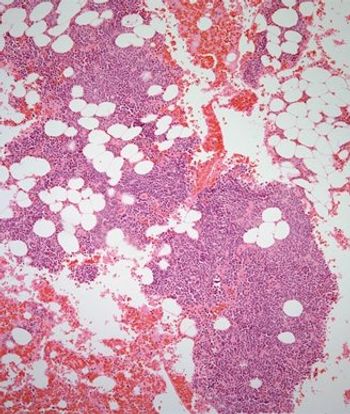
Overweight and obesity in adolescence were associated with an increased risk for colon cancer later in life among both men and women, according to the results of a recent study.

Your AI-Trained Oncology Knowledge Connection!


Overweight and obesity in adolescence were associated with an increased risk for colon cancer later in life among both men and women, according to the results of a recent study.

The FDA has announced a new comprehensive plan for tobacco and nicotine regulation designed to serve as a road map to better protect American children and reduce tobacco-related disease and death.

Adherence to each of five quality metrics for head and neck squamous cell carcinoma was associated with a reduced risk for death.

A lower dose of rabbit anti–T-lymphocyte globulin was superior to a higher dose in children with hematologic malignancies undergoing transplant from an unrelated donor.

Adherence to screening protocols at cancer centers resulted in fewer emergency department visits and hospitalizations in the 2-month period after the screening.

Patients with metastatic renal cell carcinoma had durable responses and manageable safety when treated with the combination of nivolumab and ipilimumab.

The FDA has approved the marketing of a new lab test used with flow cytometry to aid in the detection of several types of hematologic malignancies.

Higher nodal yield during definitive surgery for clinically node-negative oral cavity squamous cell carcinoma was associated with improved mortality.

Treatment of adult relapsed or refractory acute lymphoblastic leukemia with inotuzumab ozogamicin was associated with increased hepatotoxicity, especially after follow-up hematopoietic stem cell transplantation.

The FDA placed a clinical hold on three trials of the PD-1 inhibitor pembrolizumab in combination with pomalidomide or lenalidomide for patients with multiple myeloma.

Patients with advanced melanoma treated with nivolumab had higher and more durable responses compared with investigator’s choice of chemotherapy, but these increases did not result in improved survival outcomes.

Treatment of advanced melanoma with the checkpoint inhibitor nivolumab beyond RECIST-defined progression resulted in clinical benefit for selected patients, according to pooled, retrospective data from two phase III trials.

Patients with resected brain metastases who underwent stereotactic radiosurgery had lower rates of local recurrence compared with observation alone, according to the results of a phase III trial.

Patients with high-risk diffuse large B-cell lymphoma had a reduced risk of treatment failure, but no survival improvement, with an abbreviated course of rituximab-dose-dense chemotherapy plus high-dose chemotherapy and transplant compared with a full course of chemotherapy.

Use of the EGFR inhibitor cetuximab with chemoradiation did not improve survival in patients with esophageal carcinoma compared with chemoradiation alone, according to the results of the phase III RTOG 0436 trial.

Treatment with the combination of daratumumab plus pomalidomide/dexamethasone resulted in rapid, deep, and sustained responses with no new safety signals in patients with heavily treated multiple myeloma.

Treatment with the PD-1 inhibitor pembrolizumab plus metronomic cyclophosphamide had limited activity in patients with soft-tissue sarcomas and gastrointestinal stromal tumors.

Calcium and vitamin D supplementation had a protective effect against hematologic malignancies, according to a post-hoc analysis of data from the Women’s Health Initiative Calcium/Vitamin D study.

There was no significant survival difference in newly diagnosed acute myeloid leukemia patients given induction therapy with idarubicin vs high-dose daunorubicin.

Salvage surgery is associated with prolonged survival in patients with rectal cancer who have lung and liver recurrence after TME.

A phase II study has shown that savolitinib is active in a subgroup of patients with papillary renal cell carcinoma with gene amplification or mutations in the MET pathway.

A recent study shows that many women with early-stage breast cancer are still undergoing unnecessary chest CT, despite NCCN recommendations.

A new study that used prospective data provides estimates of cancer risk based on BRCA1/2 mutation status and shows the potential role of family history and the location of the mutation in assessing risk.

Lack of participation in any regular recreational physical activity was associated with a significantly increased risk for both bladder and renal cancers.

The US Food and Drug Administration has approved the optical imaging agent aminolevulinic acid hydrochloride to enhance visualization of malignant tissue during surgery for gliomas.

Patients with recurrent or metastatic squamous cell carcinoma of the head and neck treated with the checkpoint inhibitor nivolumab were able to maintain baseline levels of quality of life.

Adult patients with early thymic precursor (ETP) acute lymphoblastic leukemia (ALL), a subgroup of T-cell ALL, could benefit from the use of response-based risk stratification and therapy intensification similar to that used in pediatric patients with ETP-ALL.

Treatment with single-agent bevacizumab resulted in an improved disease-free interval in patients with resected melanoma, but no increase in overall survival compared with observation.

The primary tumor location was an independent prognostic marker in patients with RAS wild-type metastatic colorectal cancer after multivariable adjustment.

Patients with node-positive intermediate-thickness melanoma had an increased rate of regional disease control when undergoing completion lymph-node dissection for sentinel node metastases, however, there was no increase in melanoma-specific survival.